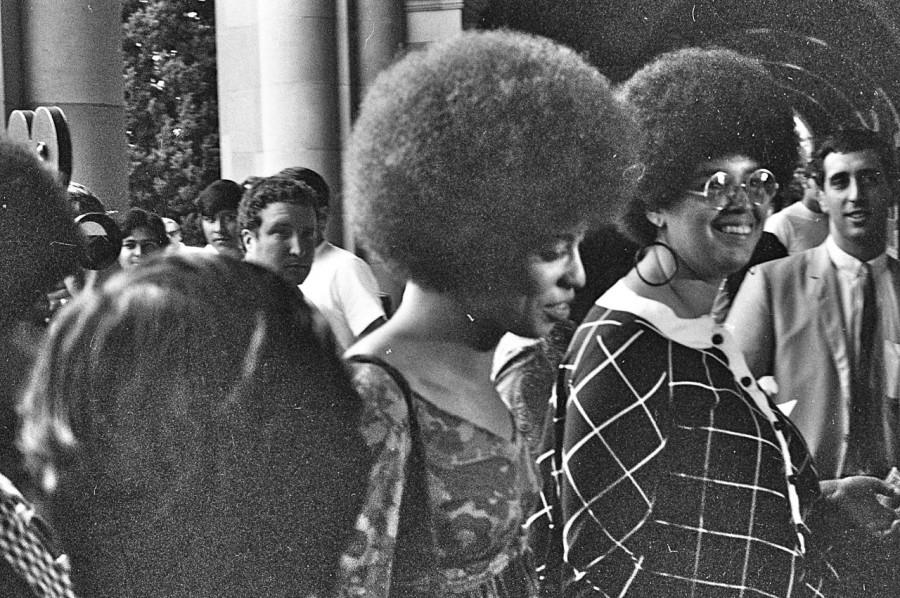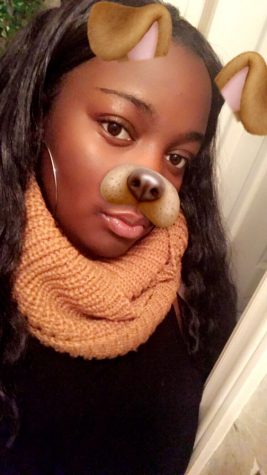It all started at the roots
https://upload.wikimedia.org/wikipedia
Smiling towards a crowd, Angela Davis, a civils rights activist, rocks her fro. The afro was a symbolic hairstyle for many women involved in these organizations. It was seen as rebellious, yet empowering.
December 17, 2015
Throughout the decades, the hairstyles of African American women have evolved. In early civilizations, many african tribes were characterized by their hairstyle. Therefore, women and the keeping of their hair became a priority. During the Civil Rights and Black Power movements, hair became a symbol for empowerment. This ultimately played a part in platforms for organizations, such as the Natural Hair Movement.
During the late 60s and early 70s at the peak of the Natural Hair Movement, the afro hairstyle became the face of the movement. The famous activist, Angela Davis was known for her afro. With that hairstyle came a dangerous assumption of being affiliated with the Black Panther Party. Other women such as Nina Simone who was popular in the music industry was also known for her hair which was worn in its natural state. To follow these celebrities, many women began to wear their hair in the natural state of kinky curly or the afro. Chaka Khan, a songwriter and singer who first came out during the 70s, was not only known for her vocals but also her big voluminous curls. Wearing her hair in such style represented empowerment and ultimately a little rebellion. This small symbol for rebellion inevitably inspired many teenagers today to go natural. Sophomore Ijoema Alaezi stated, “I feel like it influenced me by making me realize that African American hair is beautiful, and we should not try to hide it or ruin it; in fact we should embrace it.”
The afro soon started to be replaced with new hairstyles. The perm was the spark of the 80s, and after hairstyles such as the Jheri curl and waves became the trend. This dimmed the light on the natural hair movement. Once the 90s came, hairstyles such as “poetic justice” braids were made a trend because Janet Jackson was seen with them in the ‘93 movie Poetic Justice. The braids were not as lion-esque as the afro but were used as another way for African American women to protect their fro. Dreadlocks became prominently dominant amongst the women and even men. Lauryn Hill, a singer in the group The Fugees, prompted a new look in the music industry that became an inspiration for many people of the natural hair community. Another late 90s and early 2000s hairstyle that came back in fashion was cornrows. The slick braided style became a go to hairstyle for many women of the African American race, but it actually dates back as far as 3000 BC.
During the early 2000s, the hairstyle finger waves also became a common style among celebrity women. Perms, which are known to straighten the hair of African American women, also became common as well. In 2009 the documentary called Good Hair came out and changed the outlooks on women and their hair. Many new hairstyles and products came about. The popular weave became not only a popular hairstyle but was also considered an accessory for someone’s hair. Once the year 2010 rolled around, many African American women began to go back to wearing their hair back in its natural state. The natural hair movement made its way back into the black community, and many celebrities such as Solange Knowles, Viola Davis and Lupita Nyong’o showcased their fros. Junior Marcus Mason said, “These women have been major influences on black hair and black culture because young black people could finally look at a screen, paper, etc., and see that someone that looks like them and is embracing what they naturally have.” These women have inspired many teens and to literally go back to their roots.












